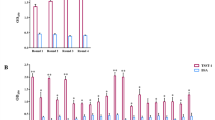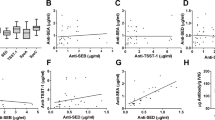Abstract
Staphylococcal enterotoxin B (SEB) and toxic shock syndrome toxin-1 are the super antigens responsible for diseases such as staphylococcal food poisoning and toxic shock syndrome. At low serum concentrations, SEB can trigger toxic shock, profound hypotension and multi organ failure and hence is recognized as biowarfare molecule. In this study, a multidomain fusion protein (r-TE) was generated with specificity for SEB and toxic shock syndrome toxin (Tsst-1). The fusion gene comprising the conserved regions of seb and the tsst genes was codon-optimized for expression in Escherichia coli and encoded a 26 kDa recombinant multidomain chimeric protein (r-TE). Hyperimmune antiserum raised against r-TE specifically reacted with SEB (~28 kDa) and Tsst-1 (~22 kDa) components during Western blot analysis and by plate ELISA in confirmed toxin producing strains of S. aureus. The antigenicity of the SEB component of the r-TE protein was also confirmed using TECRA kit. The described procedure of creating a single protein molecule carrying components of two different toxins whilst still retaining the original antigenic determinants of individual toxins proved highly advantageous in the development of rapid, reliable and cost effective immunoassays and may also have the potential to serve as candidate molecule for vaccine studies.





Similar content being viewed by others
References
Kamboj DV, Nema V, Pandey AK, Goel AK, Singh L (2006) Heterologous expression of staphylococcal enterotoxin B (seb) gene for antibody production. Electron J Biotechnol ISSN: 0717-3458. 9(5)
Mehrotra M, Wang G, Wendy JM (2000) Multiplex PCR for detection of genes for Staphylococcus aureus enterotoxins, exfoliative toxins, toxic shock syndrome toxin 1, and methicillin resistance. J Clin Microbiol 38(3):1032–1035
Blanco L, Choi EM, Connolly K, Thompson MR, Bonventre PF (1990) Mutants of staphylococcal toxic shock syndrome toxin 1: mitogenicity and recognition by a neutralizing monoclonal antibody. Infect Immun 58(9):3020–3028
De-Lourdes Maria RS, Da-Cunha RAO, Junior CJP (2007) Detection of enterotoxin, toxic shock syndrome toxin 1 genes in Staphylococcus with emphasis on coagulase negative Staphylococci. Microbiol Immunol 51(4):381–390
Kansal R, Davis C, Hansmann M, Seymour J, Parsonnet J, Modern P, Gilbert S, Kotb M (2007) Structural and functional properties of antibodies to the superantigen TSST-1 and their relationship to menstrual toxic shock syndrome. J Clin Immunol 27(3):327–338
Rajagopalan G, Sen MM, Singh M, Murali NS, Nath KA, Iijima K, Kita H, Leontovich AA, Gopinathan U (2006) Intranasal exposure to staphylococcal enterotoxin B elicits an acute systemic inflammatory response. Shock 25:647–656
Anderson MR, Tary-Lehmann M (2001) Staphylococcal enterotoxin-B-induced lethal shock in mice is T-cell-dependent, but disease susceptibility is defined by the non-T-cell compartment. Clin Immunol 98:85–94
Hemalatha V, Srikanth P, Mallika M (2004) Superantigens: concepts, clinical disease and therapy. Indian J Med Microbiol 22(4):204–211
Konno O, Hirano T, Katsuyama K, Oka K, Matsuno N, Nagao T (2007) Bacterial superantigen TSST-1 attenuates suppressive efficacy of glucocorticoids and calcineurin inhibitors against blastogenesis of peripheral blood mononuclear cells from patients with chronic renal failure on hemodialysis treatment. Transpl Immunol 17(3):187–192
Ulrich RG, Sidell S, Taylor TJ, Wilhelmsen CL, Franz DR (1997) Staphylococcal enterotoxin B and related pyrogenic toxins. In: Sidell FR, Takafuji ET, Franz DR (eds) Textbook of military medicine Part I, Warfare, weaponry, and the casualty: medical aspects of chemical and biological warfare. Washington, DC: Office of the Surgeon General, Department of the Army, United States of America, pp 621–630
Kumar TDK, Balakrishna K, Murali HS, Batra HV (2009) Construction of a recombinant intergenus multidomain chimeric protein for simultaneous expression of haemolysin BL of Bacillus cereus, listeriolysin O of Listeria monocytogenes and enterotoxin B of Staphylococcus aureus. J Med Microbiol 58:577–583
Sambrook J, Fritsch E, Maniatis A (1989) Molecular cloning: a laboratory manual, 2nd edn. Cold Spring Harbor Laboratory, Cold Spring Harbor
Lowry OH, Rosebrough NJ, Farr AL, Randall RJ (1951) Protein measurement with the folin–phenol reagents. J Biol Chem 193:265–275
Engvall E, Perlman P (1971) Enzyme-linked immunosorbent assay: quantitative assay of immunoglobulin G. Immunochemistry 8:871–874
Harlow E, Lane D (1988) Antibodies: a laboratory manual. CSHL Press, Cold Spring Harbor
Nadig S, Ramachandra Raju S, Arakere G (2010) Epidemic meticillin-resistant Staphylococcus aureus (EMRSA-15) variants detected in healthy and diseased individuals in India. J Med Microbiol 59(7):815–821
Chini V, Dimitracopoulos G, Spiliopoulou I (2006) Occurrence of the enterotoxin gene cluster and the toxic shock syndrome toxin 1 gene among clinical isolates of MRSA is related to clonal type and agr group. J Clin Microbiol 44(5):1881–1883
Acknowledgments
The authors are grateful to Director, DFRL, Mysore for his constant support and encouragement to conduct this work.
Author information
Authors and Affiliations
Corresponding author
Rights and permissions
About this article
Cite this article
Shylaja, R., Thakasi, D.K.K., Murali, H.S. et al. Application of a Chimeric Protein Construct having Enterotoxin B and Toxic Shock Syndrome Toxin Domains of S. aureus in Immunodiagnostics. Indian J Microbiol 52, 449–455 (2012). https://doi.org/10.1007/s12088-012-0269-8
Received:
Accepted:
Published:
Issue Date:
DOI: https://doi.org/10.1007/s12088-012-0269-8




